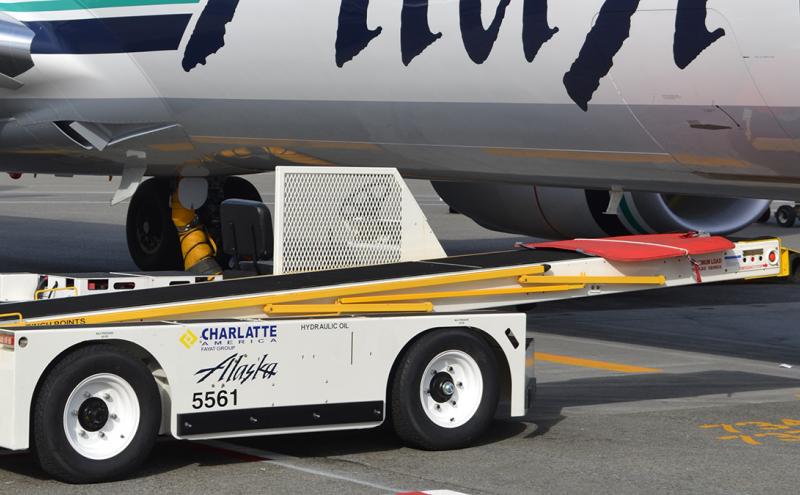
Airplanes get most of the attention at an airport, but a new project to convert the rest of the vehicles on the airfield from fossil fuels to electric power is about to save millions of dollars and tons of greenhouse gases at Seattle-Tacoma International Airport.
The Port of Seattle, along with Alaska Airlines, Western Washington Clean Cities and U.S. Representative Adam Smith today unveiled a new project providing nearly 600 electric charging stations throughout the airport for ground support equipment (GSE) such as baggage tugs, bag ramps and pushback vehicles. Converting the GSE from fossil fuel to electric, each year the project is projected to save $2.8 million in airline fuel costs and 10,000 tons of greenhouse gas emissions – the equivalent of taking 1,900 cars off the road.
"The eGSE project here at SeaTac should serve as an example of how energy efficiency is not only good for the environment, but is also a smart financial investment,” said U.S. Congressman Adam Smith. “We must continue to invest in alternative energy technologies that protect consumers, reduce greenhouse gas emissions, and strike a balance between moving away from our dependence on fossil fuels while mitigating the economic impact of that transition."
The port has installed bright yellow charging corrals with smart, fast-charging plug-ins for vehicles to receive a full charge in less than 4 hours. The smart technology determines which vehicle needs the most charge and meters out the power. This first phase provides 296 charging locations throughout concourse D, C, and the north satellite. The second phase will cover the rest of the terminal at concourse A, B, and the south satellite for a total of 576 charging locations by September.
“This project provides the infrastructure for airlines to convert their vehicles from diesel to electric in Sea-Tac’s effort to become the first major airport in the U.S. to provide charging stations at all gates,” said Courtney Gregoire, Co-President, Port of Seattle Commission. “As many as 650 vehicles could eventually be covered by electric technology and make a huge difference in the airport’s carbon footprint.”
Alaska Airlines has taken the lead in this green opportunity with 204 electric vehicles (146 with Alaska, 58 with Horizon) in operation on the ground at Sea-Tac. The environmental benefits are substantial. Alaska’s conversion to electric vehicles is the equivalent of taking 360 passenger vehicles off the road for a year, or a reduction in carbon dioxide emissions of 1,000 tons a year.
“Switching from fossil fuels to electric-powered equipment not only benefits the environment by reducing carbon emissions and fuel use, but the transition is expected to save Alaska Air Group about $300,000 a year in fuel costs,” said Jeff Butler, Alaska Airlines’ vice president of the airport operations and customer service. “These sustainability efforts help us keep our costs down in order to provide better value for our customers.”
The $31 million project is funded in large part through federal grants. The U.S. Department of Energy provided $5 million through a grant with the Western Washington Clean Cities Coalition. An additional $3.5 million came from a Federal Aviation Administration grant. Part of the grant money is being used to help airlines fund the purchase of new electric vehicles. Additional airlines are scheduled to join the program later this year.
“This project had a lot of moving parts,” said Stephanie Meyn, Program Manager for Western Washington Clean Cities. “We applaud the Port of Seattle and Alaska Airlines for their leadership, commitment and creative collaboration. They’ve helped create a successful model for other airports to achieve cleaner air, reduced reliance on petroleum, and a healthier community.”
Watch a video describing the new electric GSE system and its benefits.
Investing in Clean Air at Sea-Tac
The electric ground service equipment charging stations are part of Sea-Tac’s larger air quality strategy, which includes these recent environmentally friendly projects:
- Centralized Pre-Conditioned Air for aircraft parked at gates will save $15 million in airline fuel costs and 40,000 metric tons of greenhouse gases (began operation in July 2013),
- 48 Electric Vehicle Charging stations in the airport garage is the most of any airport in North America (added 2010 through late 2013)
- A fleet of clean, compressed natural gas (CNG) buses moves customers between the terminal and the Rental Car Facility saving 165,000 vehicle trips per month versus single rental car shuttles (opened 2012),
- Requirements for taxis serving the airport to use CNG vehicles or have high efficiency engines of 45 miles per gallon or better (2011),
- A centralized off-aircraft recycling system of large capacity, computer-monitored compactors that reduces waste sent to landfills, decreases air emissions, improves ramp safety, saves more than $250,000 each year and reduces pickup trips by 75% (2010).
- Greener Skies flight procedures - a partnership with Port of Seattle, Alaska Airlines, FAA, and Boeing - uses satellite-based guidance technology to fly more direct, optimized profile descent approaches which burn less fuel and reduce emissions and noise.
- Promote aviation biofuel development in the Pacific Northwest in a partnership with Alaska Airlines, Boeing, other airports and Washington State University.

